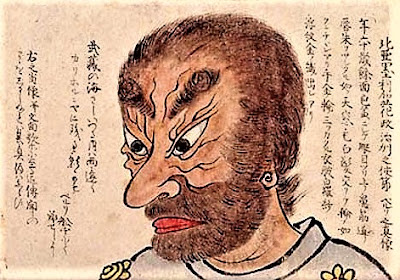Stephen Mansfield, Tokyo: A Biography. Disasters, Destruction and Renewal: The Story of an Indomitable City (Tokyo: Tuttle, 2016). Pictured above is the same author's Japans's Master Gardens: Lessons in Space and Environment (Tokyo: Tuttle, 2012).
In the mid-nineteenth century, "[Edo/Tokyo] may have had fewer open spaces and public gardens than the cities of Europe or the New World, but flowers and greenery remained an important part of . . . life. Entranceways often featured a bonsai or potted tree, while the narrow borders of the house served to display morning glories, water plants, and calabashes." (Tokyo, page 57).
"July 8, 1853, saw the arrival of Commodore Matthew Calbraith Perry's kurofune ('black ships'), as the Japanese called the four American steam-powered vessels that sailed into Edo Bay." And thus began the more than 160-year hate-love relationship between the USA and Japan, still ongoing as of this post. Pictured above: a Japanese depiction of Commodore Perry as some sort of kerasu-tengu, or "crow goblin." (See Tokyo, page 63).
Japan responded as if aliens had landed from another plant. Eventually the shogunate -- the shogun system that had lasted 268 years -- was overturned and the emperor elevated. But in the meantime: "Liberated by the prevailing instabilities, mobs congregated in Edo and other large cities, stirring hysteria by carrying Shinto images, cavorting half-naked in the streets, looting the homes of the wealthy, engaging in frenzied public sex and quasi-religious delirium, shouting out 'Ei-janai ka!' (Why not? Who cares?)." (Tokyo, page 64).
There were rice riots, cholera epidemics, earthquakes, fires and floods. More was to come. But first, in 1868, Edo was renamed Tokyo (compare Constantinople and Istanbul in Turkey).
Between the first arrival of the Americans and their black ships and the early 20th century, Japan took up Western technology and industrialization with a fervor, so much so that by 1905 Japan military forces defeated Russian Imperial forces in the Russo-Japanese War, which started with a surprise attack -- only 37 years before Pearl Harbor.
Then, on September 1, 1923, a 7.9 magnitude quake and resultant fires devastated the area in and around Tokyo. "Approximately 400,00 buildings were destroyed, and some 63 percent of Tokyo's population was made homeless." (Tokyo, page 105). More than 100,000 people perished. "From the hills of Ueno Park, the imperial capital resembled an extinct city." (Tokyo, page 106).
But from 1924 until 1943, Tokyo would rise again, until 東京大空襲 -- the Night of the Black Snow -- on March 9-10, 1945, when American bombers devastated the city once again.
Today's Rune: Fertility.
In the mid-nineteenth century, "[Edo/Tokyo] may have had fewer open spaces and public gardens than the cities of Europe or the New World, but flowers and greenery remained an important part of . . . life. Entranceways often featured a bonsai or potted tree, while the narrow borders of the house served to display morning glories, water plants, and calabashes." (Tokyo, page 57).
"July 8, 1853, saw the arrival of Commodore Matthew Calbraith Perry's kurofune ('black ships'), as the Japanese called the four American steam-powered vessels that sailed into Edo Bay." And thus began the more than 160-year hate-love relationship between the USA and Japan, still ongoing as of this post. Pictured above: a Japanese depiction of Commodore Perry as some sort of kerasu-tengu, or "crow goblin." (See Tokyo, page 63).
Japan responded as if aliens had landed from another plant. Eventually the shogunate -- the shogun system that had lasted 268 years -- was overturned and the emperor elevated. But in the meantime: "Liberated by the prevailing instabilities, mobs congregated in Edo and other large cities, stirring hysteria by carrying Shinto images, cavorting half-naked in the streets, looting the homes of the wealthy, engaging in frenzied public sex and quasi-religious delirium, shouting out 'Ei-janai ka!' (Why not? Who cares?)." (Tokyo, page 64).
There were rice riots, cholera epidemics, earthquakes, fires and floods. More was to come. But first, in 1868, Edo was renamed Tokyo (compare Constantinople and Istanbul in Turkey).
Between the first arrival of the Americans and their black ships and the early 20th century, Japan took up Western technology and industrialization with a fervor, so much so that by 1905 Japan military forces defeated Russian Imperial forces in the Russo-Japanese War, which started with a surprise attack -- only 37 years before Pearl Harbor.
Then, on September 1, 1923, a 7.9 magnitude quake and resultant fires devastated the area in and around Tokyo. "Approximately 400,00 buildings were destroyed, and some 63 percent of Tokyo's population was made homeless." (Tokyo, page 105). More than 100,000 people perished. "From the hills of Ueno Park, the imperial capital resembled an extinct city." (Tokyo, page 106).
But from 1924 until 1943, Tokyo would rise again, until 東京大空襲 -- the Night of the Black Snow -- on March 9-10, 1945, when American bombers devastated the city once again.
Today's Rune: Fertility.













1 comment:
A friend of mine has written of the time when it was called Edo. A fascinating city with such an ancient history
Post a Comment